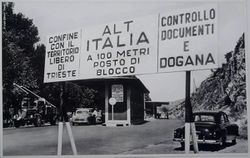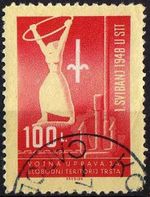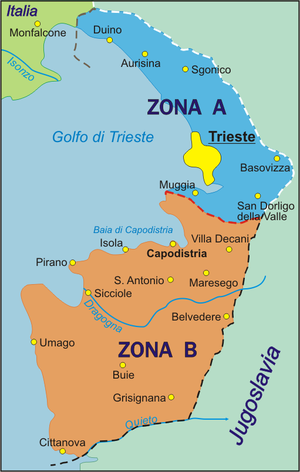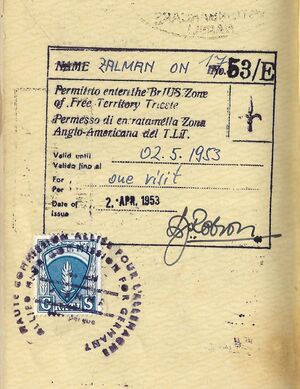إقليم ترييسته الحر
إقليم ترييسته الحر Free Territory of Trieste Territorio Libero di Trieste Svobodno tržaško ozemlje Slobodni teritorij Trsta | |||||||||||
|---|---|---|---|---|---|---|---|---|---|---|---|
| 1947–1954 | |||||||||||
النشيد: Inno Di San Giusto "Hymn to Saint Justus" | |||||||||||
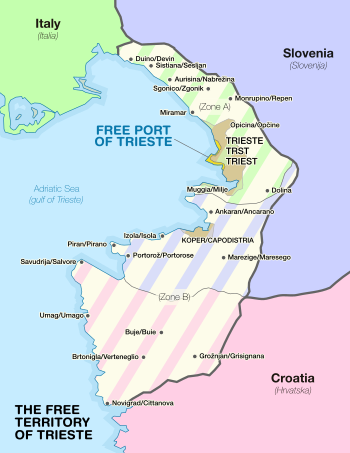 Zone A (green) and Zone B (blue and pink), indicating how the territory was split following its dissolution | |||||||||||
| المكانة | إقليم مستقل تحت المسئولية المباشرة لمجلس الأمن الدولي | ||||||||||
| العاصمة | ترييسته | ||||||||||
| أكبر مدينة | العاصمة | ||||||||||
| اللغات الشائعة | الإنگليزية (الادارية) • الإيطالية • السلوڤينية • الكرواتية • الترييسيتية | ||||||||||
| الدين | كاثوليكية، روم أرثوذكس، أرثوذكسية صربية، يهودية | ||||||||||
| صفة المواطن | ترييسيتي | ||||||||||
| الحكومة | مجلس الأمن الدولي-حكومة عسكرية مؤقتة | ||||||||||
• الحاكم | لم يُسمى أبداً | ||||||||||
• 1947–1951 | ترنس سيدني أيري ميركو لناس | ||||||||||
• 1951–1954 | توماس وينترتون ميلوش ستاماتوڤيتش | ||||||||||
| التشريع | مجلس الحكومة (لم يُشكل أبداً) | ||||||||||
| مجلش الشعب (لم يُنتخب أبداً) | |||||||||||
| تأسست | |||||||||||
| الحقبة التاريخية | الحرب الباردة | ||||||||||
| 10 يناير 1947 | |||||||||||
| 10 فبراير 1947 | |||||||||||
• تأسست | 1947 | ||||||||||
• انحلت | 1954 | ||||||||||
| Area | |||||||||||
• Total | 738 km2 (285 sq mi) | ||||||||||
| التعداد | |||||||||||
• إحصاء 1949 | 370,000 | ||||||||||
| Currency | الليرة الإيطالية (المنطقة أ) الليرة الترييسيتية (المنطقة ب)[1] | ||||||||||
| Time zone | UTC+1 (ت.و.أ.) | ||||||||||
• Summer (DST) | UTC+2 (ت.و.أ.ص.) | ||||||||||
| Antipodes | المحيط الهادي الجنوبي (بالقرب من جزر شاتهام، نيوزيلندا) | ||||||||||
| |||||||||||
| Today part of | |||||||||||
إقليم ترييسته الحر Free Territory of Trieste (إيطالية: Territorio libero di Trieste، Slovene: Svobodno tržaško ozemlje; كرواتية: Slobodni teritorij Trsta; بالترييستية والإيسترية: Teritorio Libero de Trieste)، هو إقليم مستقل كان يقع في وسط أوروپا بين شمال إيطاليا ويوغوسلاڤيا، قبالة المنطقة الشمالية من البحر الأدرياتي، تحت المسئولية المباشرة لمجلس الأمن الدولي فيما بعد الحرب العالمية الأولى.
تأسس إقليم ترييسته الحر في 10 فبراير 1947 بموجب پروتوكول معاهدة السلام مع إيطاليا من أجل استيعاب السكان المختلطين عرقياً وثقافياً في بلد مستقل محايد. كانت النية أيضاً تهدئة النزاعات الاقليمية بين إيطاليا ويوغسلاڤيا، بسبب أهميتها الاستراتيجية بالنسبة للتجارة مع وسط أوروپا. أصبحت قائمة في 15 سبتمبر 1947. قسمت ادارتها على منطقتين: الأولى تبدأ من مدينة-ميناء ترييسته مع شريط ساحلي ضيق إلى الشمال الغربي (المنطقة أ)؛ والثانية، الأكبر (المنطقة ب) كانت عبارة عن جزء صغير من المنطقة الشمالية الغربية لشبه جزيرة إستريا.
الإقليم الحر تم الاستيلاء عليه بحكم الأمر الواقع من قبل جارتيه عام 1954 ولاحقاً اكتسب هذا الاستيلاء شكلاً أكثر رسميةً بموجب معاهدة أوسيمو الثنائية عام 1975، والتي تم التصديق عليها عام 1977.[2]
. . . . . . . . . . . . . . . . . . . . . . . . . . . . . . . . . . . . . . . . . . . . . . . . . . . . . . . . . . . . . . . . . . . . . . . . . . . . . . . . . . . . . . . . . . . . . . . . . . . . . . . . . . . . . . . . . . . . . . . . . . . . . . . . . . . . . . . . . . . . . . . . . . . . . . . . . . . . . . . . . . . . . . . .
الجغرافيا
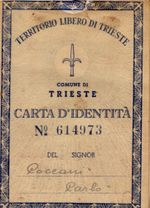
The Free Territory of Trieste comprised an area of 738 square kilometres (285 sq mi) around the Gulf of Trieste in the northern Adriatic, from Duino (Devin) in the north to Cittanova (Novigrad) in the south, and had approximately 330,000 inhabitants.
It bordered post-war Italy to the north, and Yugoslavia to the east and south. The rivers of the territory included the Rižana/Risano, the Dragonja/Dragogna, the Timavo/Timava, the Val Rosandra/Glinščica, and the Mirna/Quieto. The Territory's highest point was at Monte Cocusso/Kokoš (668 metres (2,192 ft)). Its most extreme points were near Medeazza/Medjavas at 45° 48’ in the north, at Tarski Zaliv / Porto Quieto at 45° 18’ in the south, Savudrija / Punta Salvore at 13° 29’ in the west, and Gročana/Grozzana at 13° 55’ in the east.
التاريخ
Since 1382, Trieste had been part of the Habsburg monarchy, whilst neighboring Istria had been divided for centuries between the Habsburg monarchy (its central, northern and eastern parts) and the Republic of Venice (its western and southern parts). The population of the territory has been diverse and mixed, with different and often changing ethnic majorities in different parts of the territory.[بحاجة لمصدر]
Italian-speakers have been predominant in most urban settlements and along the coast, with significant ethnic Slavic minorities of Slovenes and Croats inland - especially in the Trieste district, where Slovenes represented a third of the population by the end of World War I (although most of them were recent arrivals, after 1880, from interior Slovene districts).[3][4] The countryside of the territory was mostly populated by ethnic Slovenes or Croats in the southernmost portion of the area. There was also a smaller number of Istro-Romanians, Greeks, Albanians, as well as a sizeable Triestine Jewish community.
The local Triestine dialect reflects this ethnic mix. Based on the Romance Venetian language, the dialect was influenced by ancient Rhaeto-Romance substrate. In addition, some Triestine vocabulary are of German and Slovene origin, and there are also loanwords from other languages, such as Greek.
The variations of spoken Slovenian and Serbo-Croatian in the territory were also largely dialectal, sharing words with the Triestine and Istrian dialects. In the southernmost part of the territory, the Croatian-based dialects are of the Chakavian type, while the Venetian-based Istrian is also commonly used.
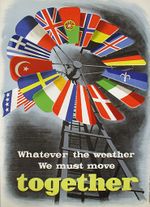
At the end of World War I in 1918 and the dissolution of Austria-Hungary, Kingdom of Italy annexed Trieste, Istria and part of modern-day western Slovenia, establishing the border region known as the Julian March (Venezia Giulia). In 1924, Italy also annexed the Free State of Fiume (now the city of Rijeka in Croatia).
During the 1920s and 1930s, the Slavic population was subject to forced Italianization and discrimination under the Italian Fascist regime led by Benito Mussolini. They were also exposed to state violence by mobs incited by the ruling fascist party PNF, which included the infamous burning of the Slovene National Hall in Trieste on 13 July 1920. Because of this, some native Slovenes and Croats emigrated to Yugoslavia, while others joined the TIGR resistance organization, whose methods included more than 100 bombings and assassinations, mostly against Italian authorities in the region, and especially in the areas around Trieste and Gorizia to the north.
الحرب العالمية الثانية
Beginning in 1940, Italy joined World War II alongside Nazi Germany as one of the Axis powers. When the Fascist regime collapsed and Italy capitulated with the Armistice of Cassibile in September 1943, the territory in and around Trieste was occupied by the German Wehrmacht armed forces, which made the city the capital of their regional Operational Zone of the Adriatic Littoral (OZAK).
Amid the collapse of German front line towards the end of the war, Yugoslav Partisan units (4th Army and the 9th Corps) entered Trieste on 1 May 1945, after a battle in the town of Opicina on the outskirts of Trieste.
The 2nd New Zealand Division also arrived the following day, and forced the surrender of some 2,000 German troops holding out in Trieste, who warily had refused to capitulate to Yugoslav troops, fearing reprisals and executions. An uneasy truce then developed between New Zealand and Yugoslav troops occupying the area, until British General William Morgan proposed partition of the territory into separate military-administered zones.
Yugoslav leader Josip Broz Tito agreed with the idea on 23 May, as the British 13th Corps was moving forward to the proposed demarcation line. A formal agreement on partition was signed in Duino on 10 June, which created the so-called Morgan Line dividing the Julian March territory. Yugoslav troops withdrew to their area on 12 June 1945.[5][6]
تأسيس الإقليم والحكومة المؤقتة
In January 1947, the United Nations Security Council approved Resolution 16 under Article 24 of its charter calling for the creation of a free state in Trieste and the region surrounding it. A permanent statute codifying its provisions was to become recognized under international law upon the appointment of an international governor approved by the Quatripartite Powers (UK, US, France, and the Soviet Union). On 15 September 1947, the peace treaty between the United Nations (UN) and Italy was ratified, establishing the Free Territory of Trieste.
Official languages were Italian and Slovene, possibly with the use of Serbo-Croatian in the portion of Zone B south of the Dragonja River. However, local government bodies were never formed, and it continued to be run by military authorities, respecting the administrative division demarcated by the Morgan Line: Zone A, which was 222.5 square kilometres (85.9 sq mi) and had a population of 262,406 - including Trieste itself - was administered by the British and American forces; Zone B, which was 515.5 square kilometres (199.0 sq mi) with 71,000 residents - including north-western Istria - was administered by the Yugoslav army.

Between October 1947 and March 1948, the Soviet Union rejected the candidacy of 12 successive nominees for the civilian governor of the territory, at which point the Tripartite Powers (United States, United Kingdom, and France) issued a note to the Soviet and Yugoslav governments on 20 March 1948 recommending that the territory be returned to Italian sovereignty.
Since no governor was ever appointed under the terms of UN Resolution 16, the Territory never functioned as a real independent state - although its formal status and separate overeignty were generally respected, and as a separate state it was involved in the Marshall Plan (launched in April 1948) and the related OEEC (formed in March 1948).[7] Meanwhile, the Tito-Stalin split in mid-1948 led to the deterioration of relations between Yugoslavia and the Soviet Union, which resulted in a political stalemate, and the proposal to return the territory to Italy was suspended until 1954.
The Allied Military Government (AMG) thus continued to administer Zone A. The governance was split into peacekeeping and law enforcement sectors, with the local command comprising 5,000 Americans in the Trieste United States Troops (TRUST) and 5,000 British personnel in the British Element Trieste Forces (BETFOR).
According to the estimates published by the Allied Military Government, the population in Zone A as of 1949 was about 310,000, which included 239,200 ethnic Italians and 63,000 ethnic Slovenes.[8]
According to contemporary Italian sources,[بحاجة لمصدر] in Zone B there were at the time 36,000 to 55,000 Italians and 12,000 to 17,000 Slovenes and Croats. According to the Yugoslav census of 1945 (which was considered falsified by the Quadripartite Commission set up by the UN),[9] in the part of Istria which was to become Zone B there were a total of 67,461 inhabitants - including 30,789 Slovenes, Serbs and Croats, 29,672 Italians, and 7,000 people of unidentified nationality.
Elections in the Territory were held twice, in 1949 and 1952, but only for municipal councils. The elections for what was supposed to be the People's Assembly (Free Territory of Trieste's national legislature) were never held.
الفض
On 5 October 1954, the London Memorandum was signed by ministers of the United States, United Kingdom, Italy, and Yugoslavia. The memorandum effectively disestablished the Free Territory of Trieste, which meant that the civilian administration was formally transferred to neighboring Italy and Yugoslavia.
Former Zone A with Trieste was given to Italy, while Zone B - which already had a separate communist civilian government since 1947 - to Yugoslavia. In addition, Yugoslavia was given some smaller parts of the former Zone A, including the city of Koper (Koppe), as well as several villages in the municipality of Muggia, like Plavje, Spodnje Škofije, Elerji, Hrvatini, Kolomban, Cerej, Premančan, and Barizoni. The castle and village of Socerb above San Dorligo della Valle was also ceded to the Yugoslav administration, according to the demarcation line defined by Annex I to the London Memorandum.
However, objections to the demarcation line and territorial claims from both sides continued. These were finally put to rest with the November 1975 signing of the bilateral Treaty of Osimo between Italy and Yugoslavia, which ended any current or future claims - as the London Memorandum had only dissolved the territory de facto, but not de jure.[10]
. . . . . . . . . . . . . . . . . . . . . . . . . . . . . . . . . . . . . . . . . . . . . . . . . . . . . . . . . . . . . . . . . . . . . . . . . . . . . . . . . . . . . . . . . . . . . . . . . . . . . . . . . . . . . . . . . . . . . . . . . . . . . . . . . . . . . . . . . . . . . . . . . . . . . . . . . . . . . . . . . . . . . . . .
حكام الإقليم
المنطقة أ
- 1 مايو 1945 - 4 يوليو 1945 الميجور جنرال برنارد سيريل فرايبرگ. (نيوزيلندا) *
- 4 يوليو 1945 - 4 يوليو 1947 الكولونيل ألفرد باومان (الولايات المتحدة)*
- 4 يوليو 1947 - 16 سبتمبر 1947 الكولونيل جيمس كارنز (الولايات المتحدة)*
- 16 سبتمبر 1947 - 31 مايو 1951 الميجور جنرال ترنس سيدني أيري (المملكة المتحدة)
- 31 مايو 1951 - 26 أكتوبر 1954 الميجور جنرال توماس وينترتون (المملكة المتحدة)
المنطقة ب
- 1 مايو 1945 - 15 سبتمبر 1947 دوشان كڤدر (يوغوسلاڤيا) *
- 15 سبتمبر 1947 - 15 مارس 1951 ميركو لناس (يوغوسلاڤيا)
- 15 مايو 1951 - 26 أكتوبر 1954 ميلوش ستاماتوڤيتش (يوغوسلاڤيا)
*حكام عموم ڤنتسيا جوليا قبل تأسيس الأرض.[11]
الاقتصاد
The economy of the territory was based on its ports, namely the Free Port of Trieste and the Port of Koper/Capodistria. The first had a peculiar free zone (nowadays also offshore) status originated in 1719[12] and confirmed by the Treaty of Peace with Italy of 1947, which allows the transportation of goods inside the area. This status is recognised by the international community and the European Union.[13][14]
An excerpt from the answer given by Algirdas Šemeta on 7 August 2012, on behalf of the European Commission about the Free Port of Trieste:[13]
Annex VIII to the Treaty of peace with Italy of 10 February 1947 stipulates in its Article 1 that the port of Trieste shall be a customs-free port. Article 5(2) of Annex VIII provides that in connection with the importation into or exportation from or transit through the Free Port, the authorities of the Free Territory shall not levy on such goods customs duties or charges other than those levied for services rendered.[13] [emphasis added]
السكان
During the late 1940s and in the years following the division of the territory, up to 40,000 people[15] (mostly Italians) chose to leave the Yugoslav Zone B and move to the Italian Zone A for various reasons: some were intimidated into leaving, and some simply preferred not to live in Yugoslavia. (See Italianization that occurred previously.) Within Yugoslavia, the people who left were referred to as optanti 'choosers', whereas they called themselves esuli 'exiles'. About 14,000 Italians chose to remain in the Yugoslav zone. The population of the Free Territory of Trieste was approximately 370,000 in 1949.
انظر أيضاً
- معاهدة السلام مع إيطاليا (1947)
- الحزب الشيوعي في أراضي ترييسته الحرة
- قرار مجلس الأمن الدولي رقم 16
- ڤنتسيا جوليا
- الخروج الإسترياني
- خط مورگان
- الساحل السلوڤيني
- مقاطعة ترييسته
- إستريا السلوڤينية
- مقاطعة إستريا
المصادر
- ^ "A/AC.25/Com.Jer/W.4". United Nations. Retrieved 5 June 2013.
- ^ أ ب Drašček, Nuša. "Slovenska zahodna meja po drugi svetovni vojni", diplomsko delo, Univerza v Ljubljani, Ljubljana, 2005
- ^ "Archived copy" (PDF). Archived from the original (PDF) on 20 December 2013. Retrieved 19 June 2013.
{{cite web}}: CS1 maint: archived copy as title (link) - ^ "Ljudsko štetje Avstrijskega-ilirskega Primorja 31. decembra 1910 – Österreichisch-Illyrisches Küstenland – Volkszählung von 31. Dezember 1910 – Censimento del Litorale Austriaco-illirico del 31 dicembre 1910". www.kozina.com. Archived from the original on 14 March 2018. Retrieved 10 September 2017.
- ^ "Stanford University". stanford.edu. Archived from the original on 21 July 2006. Retrieved 10 September 2017.
- ^ "Ashburton Guardian". ashburtonguardian.co.nz. Archived from the original on 27 June 2006. Retrieved 10 September 2017.
- ^ "Organisation for European Economic Co-operation – OECD". www.oecd.org. Retrieved 2015-09-24.
- ^ "Settling the Question of Trieste". Archived from the original on 9 March 2016. Retrieved 24 March 2010.
- ^ "Venezia Giulia: Area of Dispute". Intelligence Review (3): 30–36. February 28, 1946. Archived from the original on 9 March 2016. Retrieved 10 September 2017.
- ^ Tržaški Slovenci in vprašanje razdelitve Svobodnega tržaškega ozemlja, pages 411–422
- ^ Worldstatesmen / Italy / Trieste by Ben Cahoon
- ^ "The port of Trieste and its railway connections in the Habsburg monarchy: economic change and infrastructure problems, 1850–1918" (PDF). docutren.com. Archived from the original (PDF) on 21 يونيو 2012. Retrieved 10 سبتمبر 2017.
- ^ أ ب ت "Answer to a written question – Free Port of Trieste – E-006217/2012". www.europarl.europa.eu. Retrieved 10 September 2017.
- ^ "The jurisdictional regime of the Free Zones (in Italian)". isdit.it. Archived from the original on 18 فبراير 2013. Retrieved 10 سبتمبر 2017.
- ^ Petacco, Arrigo (1999). The Exodus. The Story of the Italian Population of Istria, Dalmatia, and Venezia Giulia. Milan: Mondadori.
وصلات خارجية
- Vintage Life Magazine Photos of Trieste at Google Images.
- Pages using gadget WikiMiniAtlas
- Articles containing إيطالية-language text
- Pages using center with no arguments
- Pages using infobox country with unknown parameters
- Pages using Lang-xx templates
- Articles containing Slovene-language text
- Articles containing كرواتية-language text
- Articles with hatnote templates targeting a nonexistent page
- Articles with unsourced statements from February 2013
- Articles with unsourced statements from March 2020
- Coordinates on Wikidata
- إقليم ترييسته الحر
- مدن-دويلات
- احتلال الحلفاء لأوروپا
- تاريخ يوغوسلاڤيا
- العلاقات الإيطالية اليوغوسلاڤية
- تبعات الحرب العالمية الثانية



